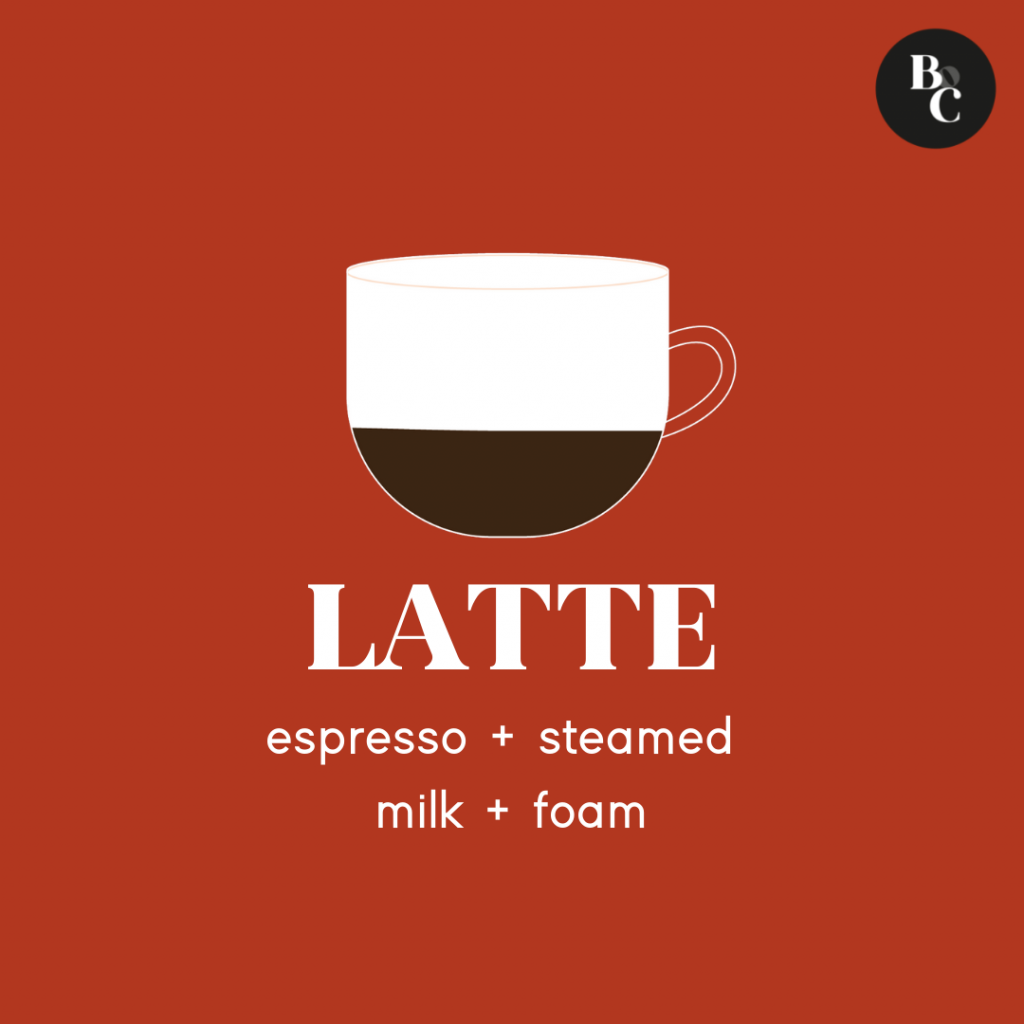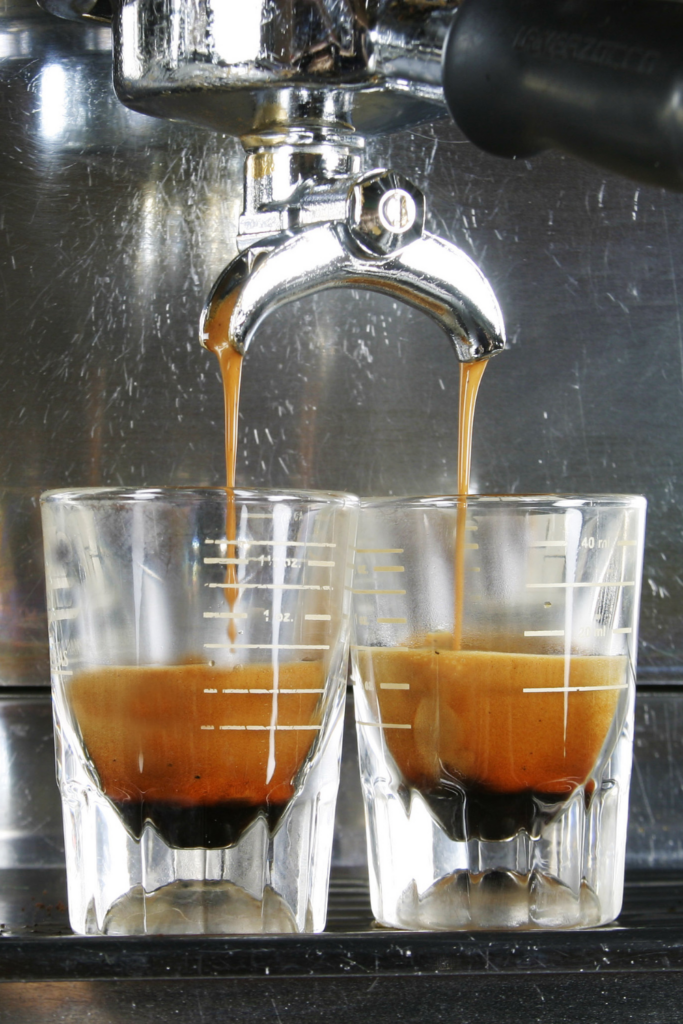Flat White and Latte can be tough to distinguish. When prepared by some baristas, the two drinks are practically identical.
Then why should they be listed as two distinct menu options?
The truth is, it’s up for debate. Some people say the size of the drink, the type of espresso used, and the volume of foam make all the difference.
In this article, I’ll explain the origins of each drink, what (usually) makes them different, and their similarities. You’ll also get a primer on how to assemble your own at home.
Here’s the 101.
What is a Latte?

A cafe latte is the milkiest of the traditional espresso-based drinks.
It’s fast and easy to prepare, with an incredibly creamy texture and sweet flavor derived from the steamed milk.
Sweeteners and flavor inclusions are added in many cafes to enhance the drink’s flavor profile.
There may be nothing more hallmark of a latte than the art. For a skilled barista, making hot steamed whole milk is the perfect consistency to create incredible designs.
Traditionally, a latte is prepared as an 8-12 ounce drink. It uses a 1:3 ratio of coffee to milk, meaning that 2 ounces of espresso are mixed with 6 ounces of milk.
Today, the traditional size and dose have gone out the window in many mainstream cafes. For example, you can get a good 20-ounce latte with 10x more milk than coffee at Starbucks.
Regardless of where you order, the fundamentals of a latte are constant.
Adding sweet and creamy milk drowns out the intensity and bitterness of the espresso.
And, unlike cappuccino, the cup only has a thin foam layer.
What is a Flat White?

The origin story of a flat white is unclear, as are the standards for making it.
Most think this drink originated in either Australia or New Zealand during the 1980s, and both countries now claim it as their own.
Flat whites are usually prepared in a small ceramic mug, between 3-7 fluid ounces.
This drink’s “flat” name came about because it has only a tiny layer of smooth microfoam on top of it. And the color of flat whites aren’t really white. It’s more of a light brown complexion.
Is it actually different than a latte? It depends on who you ask.
The basis of a flat white is a double shot of standard espresso, although sometimes it is prepared using a single. If you’re ordering in the US, a flat white is often prepared using ristretto – a short, concentrated espresso pull.
Whole milk is heated and stretched with a steam wand. It’s only frothed with the utmost brevity, so the foam is minimal.
Drink assembly is straightforward. Add espresso. Pour milk. Add foam.
Differences Between Flat White vs Latte

There is no universally accepted standard for what makes a flat white. And, these days, it seems that the definition of a latte is highly negotiable too.
Given these facts, providing an exacting list of differences between a flat white vs latte is difficult. In fact, some say a flat white is nothing more than a small latte.
In my experience, there tends to be a few common distinctions. I’ll break down the differences between flat white vs latte below.
Here’s what you can come to expect when ordering at your local coffee shop!
Size
A latte is almost always the larger, less concentrated beverage. For some reason, baristas love to pour on more milk!
A common size for a cafe latte is 10-12 ounces, although you can easily find one twice as large.
A flat white is usually served as a 5-8 ounce drink. It’s petite and tastes strong because it is less diluted with milk.
Foam
Flat whites will usually have half the foam of lattes.
If a latte has thin foam, compared with a cappuccino, then a flat white only has microfoam.
It’s there, but it’s very petite.
Milk
Most cafes take an open interpretation of what milk can be used in a latte. And there are a ton of options and alternatives available!
- Reduced fat dairy? You got it.
- Plant-based milk? Sure thing.
- Eggnog? Not for me, but you do you!
Baristas tend to be more conservative when it comes to flat whites. Whole milk is traditional, and it’s probably the only option they’re serving up unless you’re at a chain.
Presentation
There’s not a big difference with takeaway cups. But you may notice a slight alternative in the presentation if you’re ordering to “dine in” at a third-wave cafe.
In many cases, especially in Australia, a cafe latte is served in a glass. But a flat white is served in a ceramic mug.
Again, this depends on where you’re ordering, and you may find that your local coffee shop does nothing to distinguish the serving vessel.
How To Make Flat White
The entire drink assembly is done in a single ceramic cup when preparing a flat white.
1: Pull Espresso
We’ve covered the basics of espresso prep elsewhere, so I’ll stick the broad strokes when it comes to technique here.
The important thing is that you’ll need an espresso machine at home to do it properly (check out our favorite De’Longhi Espresso Machines here).
Pull an espresso doppio (2-oz, double shot) directly into the ceramic mug using a 1:1 dosing ratio. This means 17 grams of finely ground coffee beans will yield 17 grams of espresso liquid coming out.

The duration of the extraction should be about 25 seconds.
Although I’d recommend starting with a standard espresso pull, some baristas prefer to use ristretto instead. Try both and find what works for you!
2: Steam Milk
Start by adding whole milk to your pitcher. Do all of your normal station prep, and be sure to purge the steam wand first. This will prevent any condensed liquid from transferring into the pitcher.
Your goal is to make the milk warm, textured, and flat. This means we want very little foam, and you should only keep the wand near the surface of the pitcher for about a second to begin the steaming process.
Just enough air should be added to fold into the milk, but not enough to froth it. The end result should be velvety with only a slim microfoam on the pour.
3: Assemble
Pour milk from the pitcher into the center of the ceramic mug, which should already have espresso waiting in it. Do this from a few inches above the rim of the mug.
The milk will circulate through the espresso, creating a layered look that is light brown or almost orange. You want only the slightest microfoam atop the 5-7 ounce drink. Less than ¼”.
Once you’ve poured the milk, you’re good to go! That’s it.
How To Make A Latte
1: Plan Your Dose
Start by planning your dose. A traditional cafe latte is prepared using an espresso double shot and 6 ounces of milk (a 1:3 ratio). You can take liberty with your coffee-milk ratio.
I wouldn’t stretch my espresso beyond a 1:10 ratio, so if you’re preparing a drink that is bigger than 10 ounces, plan to add a second shot.
2: Pull Espresso
Pull the espresso into a glass or ceramic latte mug. Remember to pre-warm the cup so it holds the temperature of the drink for longer.
3: Steam Milk
This process happens faster than you might expect. Depending on your machine, the milk should take anywhere from 4-8 seconds to reach the desired temperature (155 F). Use a thermometer to monitor progress.
Keep the steam wand on the surface of the milk for only 1-2 seconds so that air bubbles are forced into the milk, but little foam is created.
4: Assemble
Pour the steamed milk into the mug to combine it with the espresso. Angle your mug slightly so that the milk hits the surface of the espresso at 90 degrees.
Start the pitcher about 2 inches above the rim of the mug. Drop it down and increase the pour speed as it fills. Latte art is optional.

Aim for ½” of foam to top the finished latte, and you’re ready to enjoy it!
FAQ
In most cases, a latte has more milk than a flat white and is served in larger portions. The traditional coffee-to-milk ratio for a cafe latte is 1:3. But today, it’s often served with significantly more milk. Sometimes at greater than a 1:10 ratio.
In most cases, a flat white is prepared with an espresso doppio or two 1-ounce shots of espresso.
Flat white goes by many names, often interchangeably with “latte.” There are subtle differences, mostly related to the size of the drink and the amount of foam to top it. Flat whites have sometimes gone by the name of “magic” or “wet cappuccino.” It really depends on where you order and the preparation style used by the barista.
A flat white is a more concentrated drink that will have a stronger taste of coffee than milk. It can also be stronger than a latte in terms of caffeine because you are brewing two shots, but they both use the same type of coffee beans.
Looking for more expert coffee guides? Head over to one of these posts!
